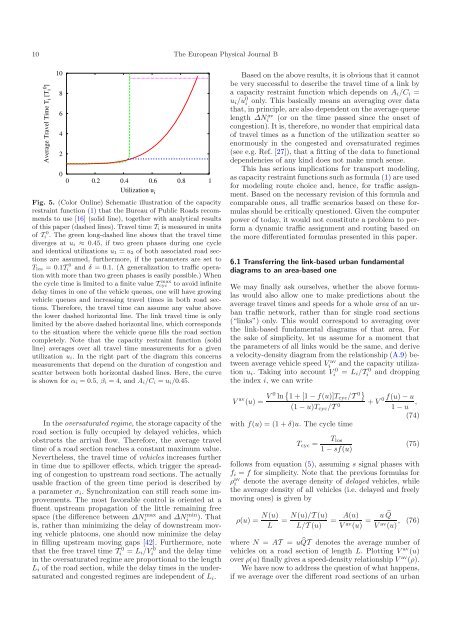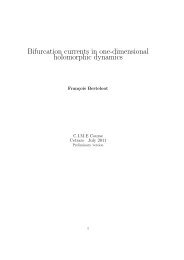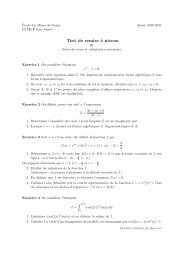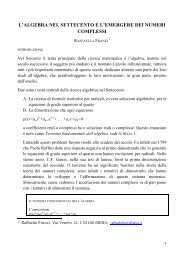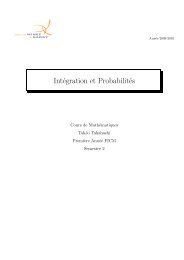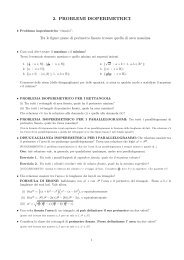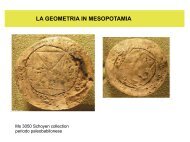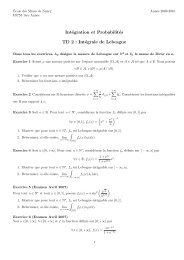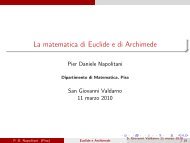Derivation of a fundamental diagram for urban traffic flow
Derivation of a fundamental diagram for urban traffic flow
Derivation of a fundamental diagram for urban traffic flow
Create successful ePaper yourself
Turn your PDF publications into a flip-book with our unique Google optimized e-Paper software.
10 The European Physical Journal B<br />
Average Travel Time T i [T i<br />
0 ]<br />
10<br />
8<br />
6<br />
4<br />
2<br />
0<br />
0 0.2 0.4 0.6 0.8 1<br />
Utilization u i<br />
Fig. 5. (Color Online) Schematic illustration <strong>of</strong> the capacity<br />
restraint function (1) that the Bureau <strong>of</strong> Public Roads recommends<br />
to use [16] (solid line), together with analytical results<br />
<strong>of</strong> this paper (dashed lines). Travel time T i is measured in units<br />
<strong>of</strong> Ti 0 . The green long-dashed line shows that the travel time<br />
diverges at u i ≈ 0.45, if two green phases during one cycle<br />
and identical utilizations u 1 = u 2 <strong>of</strong> both associated road sections<br />
are assumed, furthermore, if the parameters are set to<br />
T los =0.1Ti<br />
0 and δ =0.1. (A generalization to <strong>traffic</strong> operation<br />
with more than two green phases is easily possible.) When<br />
the cycle time is limited to a finite value Tcyc<br />
max to avoid infinite<br />
delay times in one <strong>of</strong> the vehicle queues, one will have growing<br />
vehicle queues and increasing travel times in both road sections.<br />
There<strong>for</strong>e, the travel time can assume any value above<br />
the lower dashed horizontal line. The link travel time is only<br />
limited by the above dashed horizontal line, which corresponds<br />
to the situation where the vehicle queue fills the road section<br />
completely. Note that the capacity restraint function (solid<br />
line) averages over all travel time measurements <strong>for</strong> a given<br />
utilization u i. In the right part <strong>of</strong> the <strong>diagram</strong> this concerns<br />
measurements that depend on the duration <strong>of</strong> congestion and<br />
scatter between both horizontal dashed lines. Here, the curve<br />
is shown <strong>for</strong> α i =0.5, β i =4,andA i/C i = u i/0.45.<br />
In the oversaturated regime, the storage capacity <strong>of</strong> the<br />
road section is fully occupied by delayed vehicles, which<br />
obstructs the arrival <strong>flow</strong>. There<strong>for</strong>e, the average travel<br />
time <strong>of</strong> a road section reaches a constant maximum value.<br />
Nevertheless, the travel time <strong>of</strong> vehicles increases further<br />
in time due to spillover effects, which trigger the spreading<br />
<strong>of</strong> congestion to upstream road sections. The actually<br />
usable fraction <strong>of</strong> the green time period is described by<br />
a parameter σ i . Synchronization can still reach some improvements.<br />
The most favorable control is oriented at a<br />
fluent upstream propagation <strong>of</strong> the little remaining free<br />
space (the difference between ΔNi<br />
max and ΔNi<br />
min ). That<br />
is, rather than minimizing the delay <strong>of</strong> downstream moving<br />
vehicle platoons, one should now minimize the delay<br />
in filling upstream moving gaps [42]. Furthermore, note<br />
that the free travel time Ti 0 = L i /Vi<br />
0 and the delay time<br />
in the oversaturated regime are proportional to the length<br />
L i <strong>of</strong> the road section, while the delay times in the undersaturated<br />
and congested regimes are independent <strong>of</strong> L i .<br />
Based on the above results, it is obvious that it cannot<br />
be very successful to describe the travel time <strong>of</strong> a link by<br />
a capacity restraint function which depends on A i /C i =<br />
u i /u 0 i only. This basically means an averaging over data<br />
that, in principle, are also dependent on the average queue<br />
length ΔNi<br />
av (or on the time passed since the onset <strong>of</strong><br />
congestion). It is, there<strong>for</strong>e, no wonder that empirical data<br />
<strong>of</strong> travel times as a function <strong>of</strong> the utilization scatter so<br />
enormously in the congested and oversaturated regimes<br />
(see e.g. Ref. [27]), that a fitting <strong>of</strong> the data to functional<br />
dependencies <strong>of</strong> any kind does not make much sense.<br />
This has serious implications <strong>for</strong> transport modeling,<br />
as capacity restraint functions such as <strong>for</strong>mula (1)areused<br />
<strong>for</strong> modeling route choice and, hence, <strong>for</strong> <strong>traffic</strong> assignment.<br />
Based on the necessary revision <strong>of</strong> this <strong>for</strong>mula and<br />
comparable ones, all <strong>traffic</strong> scenarios based on these <strong>for</strong>mulas<br />
should be critically questioned. Given the computer<br />
power <strong>of</strong> today, it would not constitute a problem to per<strong>for</strong>m<br />
a dynamic <strong>traffic</strong> assignment and routing based on<br />
the more differentiated <strong>for</strong>mulas presented in this paper.<br />
6.1 Transferring the link-based <strong>urban</strong> <strong>fundamental</strong><br />
<strong>diagram</strong>s to an area-based one<br />
We may finally ask ourselves, whether the above <strong>for</strong>mulas<br />
would also allow one to make predictions about the<br />
average travel times and speeds <strong>for</strong> a whole area <strong>of</strong> an <strong>urban</strong><br />
<strong>traffic</strong> network, rather than <strong>for</strong> single road sections<br />
(“links”) only. This would correspond to averaging over<br />
the link-based <strong>fundamental</strong> <strong>diagram</strong>s <strong>of</strong> that area. For<br />
the sake <strong>of</strong> simplicity, let us assume <strong>for</strong> a moment that<br />
the parameters <strong>of</strong> all links would be the same, and derive<br />
a velocity-density <strong>diagram</strong> from the relationship (A.9) between<br />
average vehicle speed Vi<br />
av and the capacity utilization<br />
u i . Taking into account Vi 0 = L i /Ti<br />
0 and dropping<br />
the index i, wecanwrite<br />
V av (u) = V 0 ln { 1+[1− f(u)]T cyc /T 0}<br />
(1 − u)T cyc /T 0 + V 0 f(u) − u<br />
1 − u ,<br />
(74)<br />
with f(u) =(1+δ)u. The cycle time<br />
T cyc =<br />
T los<br />
1 − sf(u)<br />
(75)<br />
follows from equation (5), assuming s signal phases with<br />
f i = f <strong>for</strong> simplicity. Note that the previous <strong>for</strong>mulas <strong>for</strong><br />
ρ av<br />
i denote the average density <strong>of</strong> delayed vehicles, while<br />
the average density <strong>of</strong> all vehicles (i.e. delayed and freely<br />
moving ones) is given by<br />
ρ(u) = N(u)<br />
L<br />
N(u)/T (u)<br />
= = A(u)<br />
L/T (u) V av (u) =<br />
u ̂Q<br />
V av (u) , (76)<br />
where N = AT = u ̂QT denotes the average number <strong>of</strong><br />
vehicles on a road section <strong>of</strong> length L. Plotting V av (u)<br />
over ρ(u) finally gives a speed-density relationship V av (ρ).<br />
We have now to address the question <strong>of</strong> what happens,<br />
if we average over the different road sections <strong>of</strong> an <strong>urban</strong>


